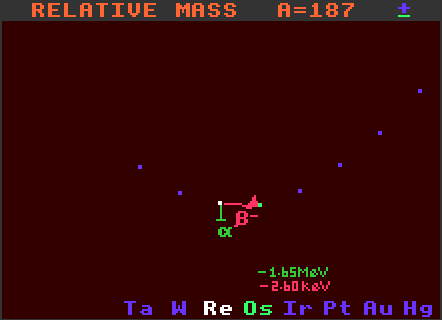
BETA DECAY ENHANCEMENT
BETA DECAY STABILITY ENHANCEMENT BY ORBITAL ELECTRONS
The great halflife (42,000 million years) of the beta decaying rhenium-187 is a result of the very small difference between the mass of rhenium-187 itself, and its daughter product, osmium-187, which amounts to an mass difference of only 2.6KeV, miniscule in comparison to most other nuclear decay energies. With such a small mass difference between parent and daughter, then the surrounding orbital electron orbits can have a profound influence on the resulting stability. Indeed, if rhenium-187 is fully ionised and without any orbiting electrons, then it is no longer subject to beta decay and is instead fully stable. This is because beta decay involves the emission of an electron, and the emission of the electron is aided by the very small repulsive force of surrounding orbital electrons. In fully ionised rhenium-187 the absence of orbital electrons is sufficient to sway the fine balance of stability in favour it being fully stable.

Relative Mass plot for rhenium-187 and osmium-187
See Halflife Constancy.




![]()